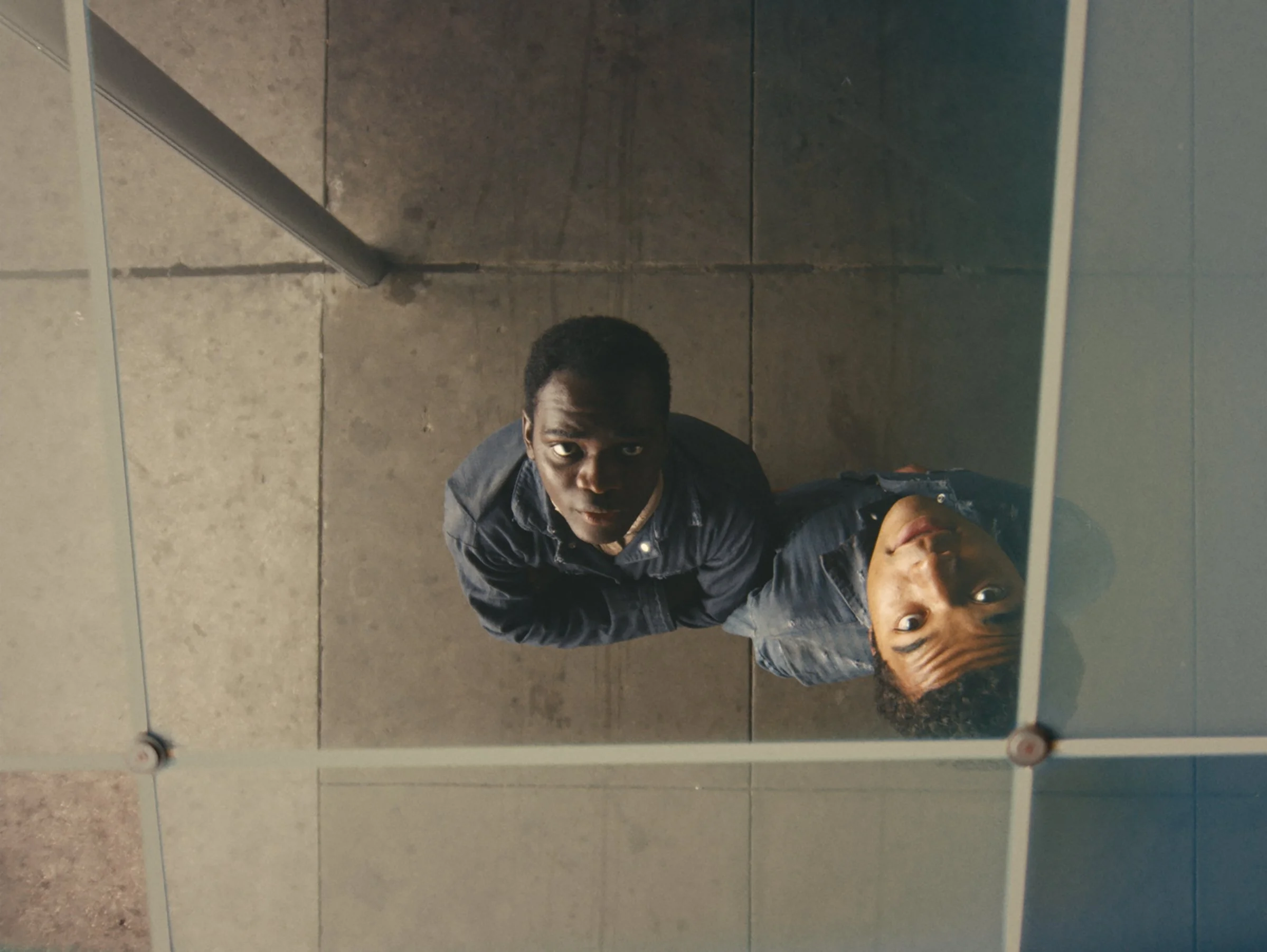Nickel Boys: Harrowing Real Life Reform School Drama Breaks Visual Rules
By Liam Lacey
Rating: A-
According to film critics groups in Toronto, New York, Chicago and Los Angeles, the best movie of the year is RaMell Ross’ Nickel Boys.
It’s the story of two teen-aged friends, Elwood and Turner, in a brutal segregated reform school in the 1960s in Florida. The story is a couple of steps removed from the reality upon which it’s based.
Ross and co-writer Joslyn Barnes adapted Colson Whitehead’s 2019 Pulitzer Prize-winning novel, The Nickel Boys, a fictionalized version of Florida’s notorious Arthur G. Dozier School for Boys. Testimonies of former inmates recount abuse, rape, torture and murder. Bodies found in unmarked graves showed evidence of gunshot wounds and blunt-force trauma.
Elwood (Ethan Herisse) and Turner (Brandon Wilson) in Nickel Boys
Anyone looking for an uplifting story in the mode of Spotlight or Erin Brockovich won’t find gratification in Ross’s sombre film. Nickel Boys, a film that impresses and occasionally perplexes, is not a story of delayed justice achieved, or the suffering of others appreciated from a safe historical distance.
The school, which was established less than forty years after the abolition of slavery, wasn’t closed until 2011, followed by the archeological investigation. Just last summer, a bill to compensate the victims of the Dozier school was passed in the Florida legislature and signed into law. Applicants had until Dec. 31 of last year to file for their share of a $20-million compensation fund.
Nor is there the consolation of viewing this as an isolated case. Though circumstances vary from place to place, ongoing revelations about children abused in institutions, from reform schools, orphanages and aboriginal residential schools, are all around us.
But what makes Nickel Boys stand out is its radical visual style, designed to break the rules on depictions of Black subjects. This is a narrative feature from Ross, and very much of a piece with his celebrated 2018 documentary, Hale County, This Morning, This Evening.
That film, which, compressed five years of shooting into a 76–minute running time, followed the lives of two young Black men, one a basketball player headed to university, the other a struggling young father. Threaded with images of beauty and fear, the film was shot in the same Alabama county depicted in Walker Evans and James Agee’s 1941 book, Let Us Now Praise Famous Men, focusing on impoverished white tenant farmers.
Ross, a visual arts professor with a fine arts photography practice, used Hale County as an exploration of what it means to put Black people on film, with subtitles asking how “we came to be seen,” “How do we not frame someone,” and “Where does time reside?” The director has described the style of Nickel Boys as a “direct lift” of the Hale County approach.
Applied to Whitehead’s traditional narrative, it’s intended as “an intervention, if not a statement, on the relationships between the camera and people of colour across the globe.”
In practice, that’s led him to a literal emphasis on a first-person point of view, where the camera, in effect, acts as the eyes of the character, and other actors communicate directly to the camera. The approach, employed in Nickel Boys to a degree that hasn’t been encountered in a mainstream movie since the 1947’s Lady in the Lake (directed by actor and star, Robert Montgomery). It was a commercial failure that is credited with ending his career with MGM.
At first, Nickel Boys is exhilarating. Early scenes place us in a giddy psychological space as Jomo Fray’s intimate camera takes us through a montage of childhood stream-of-consciousness from a boy, Elwood, seen only in brief reflections:
Images of sunlight pouring through an orange tree in his Tallahassee backyard, the whisky glasses and cards at kid’s eye level on a dining room table, a playground fall. The layered soundtrack, brings the sounds of insect drones and distant adult voices and Martin Luther King’s ringing oratory from the television.
Later, fear enters the picture, as Elwood (Ethan Herisse) grows into his teens. His eyes are always on the ground, catching the attraction of women’s bare legs, but also fear: An alligator crawls along a gutter under a street light. Elwood faces the angry gaze of an elderly White man, who repeatedly jabs him in the chest with his cane, before being led across the street by a policeman.
When Elwood, still unseen on camera, attends high class, he meets his teacher, Mr. Hill (Jimmie Fails), who, as the class starts, hands out Magic Markers and tells the class: “The first order of business in my class will be to strike out all the latest epithets of white youth which are quite imaginative.”
Only by checking back to Whitehead’s novel was I able to understand that the textbooks were second-hand, passed on from the local White high school, and the former owners had defaced the books with racial insults.
Mr. Hill is one of those inspirational teachers you might meet in a more conventional film, a former Freedom Rider with a scar above one eye, incurred in a beating during a civil rights action. He recognizes Elwood’s intellectual promise and encourages him to attend a nearby free technical college to get ahead in life.
Instead, it proves an entrance to a different kind of education. When Elwood hitches a ride to the new school, unwittingly in a stolen car, he soon finds himself shipped off to the boys’ prison known as the Nickel Academy.
We first clearly see Elwood when he has breakfast at the school’s cafeteria, and strikes up a conversation with another boy, Turner (Brandon Wilson), a re-offender from Houston, who has enough size and swagger to fend off the bullies and predators. The entire scene, and dialogue, word for word, is repeated from Turner’s perspective, and for the first time we see Elwood, a literal case of finally “being seen,” a sad, nervous kid, with hunched shoulders and a formal way of speaking.
From then on, the point of view switches between the two characters, in an intersubjective bond, an identity merger that goes beyond friendship.
Elwood’s grandmother, Hattie (Aunjanue Ellis-Taylor), a figure of solar powered warmth in the film, tries to visit Elwood but meets Turner instead: When she isn’t allowed to see her grandson, she embraces Turner (actually the camera, or us, the viewer, instead.)
But every bond is a potential betrayal. The fact that Elwood has someone on the outside rooting for him, while Turner does not, is a source of tension between them, beyond their opposite dispositions. Turner is a cynic; Elwood, still the idealist inspired by Martin Luther King, keeps a notebook documenting the abuses at the school with the hopes of one day bringing them to light and finding justice.
While nominally an educational institution, The Nickel Academy uses children who look no more than six (there were inmates that young in the Dozier school) as unpaid labour, to pick fruit, work for the prison staff and black market goods from the state-funded school kitchen.
Rule breakers are whipped, put in a “hot box” or, in some cases, taken out back and made to disappear. As Turner bluntly explains, there are four ways out: Age out, get a miraculous legal reversal, die or run away.
One of the ideas in Hale County, carried over to Nickel Boys, is to distort the sense of time’s passing, in a film where the chronology seems to scatter and focus, then scatter again in montages of imagery.
In the weaker second half of the film, we jump to the mid-‘70s and ahead to 2003 and 2004. There are glimpses of black and white photographs and interstitial footage, of NASA missions and the sounds of political speeches. A time-lapse sequence, encompassing day and night, through the door of a travelling box car baffles, but later turns out to be an event from the future.
Other scenes feel as though they should come with a metaphor warning: An alligator crawling across a classroom floor, a stoic grey mule standing in a school hallway. Enough already.
In later scenes, now set outside of Nickel Academy, where Ross takes a different shooting approach and you are encouraged to pay attention. A man (Daveed Diggs), shot from behind, wearing short dreads, sits at a computer screen, examining newspaper articles and images of shards of bone, iron rings, marbles and coins among the excavations around the Nickel Academy.
The physical evidence confirms its former inmates’ shredded memories. The montage of images that close the film make it feel as if the story ends in tatters.
Most American mainstream movies cling to predictability, like a child tugging on its parent’s sleeve. Nickel Boys rejects that approach and Ross’s avoidance of sensationalism and onscreen violence feels responsible and respectful. But it’s an imaginative experiment that can also feel distractingly mannered. You can think of it as an impressionistic companion piece to Whitehead’s sombre, solidly researched book. I recommend them as a package.
Nickel Boys. Directed by RaMell Ross. Written by RaMell Ross and Joslyn Barnes, based on the novel, The Nickel Boys, by Colson Whitehead. Stars Ethan Herisse, Brandon Wilson, Hamish Linklater, Fred Hechinger, Daveed Diggs, Aunjanue Ellis-Taylor. Now playing in various cities, including in Toronto at the TIFF Lightbox.



